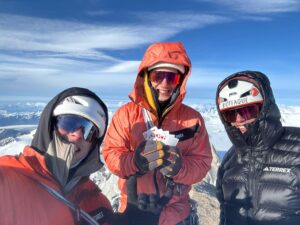Climbing a 1,400m line with difficulties up to 6b+/A2 M5+ 80º is tough. Spending seven days on the wall and seven nights on a portaledge with near-strangers is possibly even riskier. But it worked out great for four Spaniards on 6,454m Bhagirathi III in India’s Garwhal Himalaya.
Mikel Saez de Urabain, Chemari Andres, Ruben Perez, and Alexander Kammerlander successfully followed the old mountain adage, “Come back safe, come back as friends, make the summit — in that order.”

On the summit. Photo: Expedition team
“The team was just excellent,” Perez told Explorersweb. “For me, it was the best of the entire experience.”
Probably the fact that all of them are seasoned big wall climbers helped. The lovely scenery, amid giants such as Shivling, Meru, and Thalay Sagar, did the rest.
The altitude, however, was not so easy to deal with.
The climbers all had day jobs and families and could only devote a month for the whole expedition. This prompted them to hurry to the foot of the wall with less acclimatization than they had wished. It also forced two of them to retreat to Gangotri village for several days before rejoining the team.

The west face of Bhagirati III, with Stairway to Heaven (2) and the Scottish route (3). Photo: Ondrej Huserka/AAJ
“We wanted to complete the route known as Stairway to Heaven, following its originally planned line to the summit,” Perez explained.
The German team that opened that route in 2004 had to alter their course when a storm left a pillar on the upper side of the wall in very bad condition. About halfway, they had to rappel in a big pendulum in order to move to a previously climbed the 1982 Scottish route.
The Spaniards hoped to do the final pitches that the Germans had left undone. But after five days on the portaledge, they realized they didn’t have enough time. They had to choose between climbing some more pitches of the Stairway to Heaven or reaching the summit via the Scottish route.
They chose the second and launched a final push on Oct. 25 at 2 am. They climbed all day and through the following night.

Scrambling on the final ramps. Photo: Expedition team
“[Finally], we came to the end of the rock face,” said Perez. “Theoretically, above us should have been snow ramps leading to the summit. But this year, the mountains of Garhwal were extremely dry. Instead of snow/ice ramps, we found rocky slopes of 60º, steep and rotten. We split into two rope teams, each using one of our two ropes.”
While on the face, the team proceeded capsule-style: They set up a portaledge midway up the route and fixed the pitches above it, returning to the bivy every night. They then jumared up again on the following day and continued working. They didn’t return to the base of the wall until they summited.

One of the portaledges pitched midway up the face. Photo: Expedition team
The team fixed a total of 500m of rope on the 1,400m route and set up two bivouacs: one at the base of the face and the second — consisting of two portaledges — at about midway up the wall. Their bivy was very close to the point where they traversed from Stairway to Heaven to the Scottish route.
The team took shifts to fix, climb, and carry loads. They also had to stop at the base of the face because of a storm.
“We had no weather forecasts because satphones are forbidden in India,” Perez noted.
They reached the summit at 9 am on Oct. 26 and returned to the portaledge for a final rest on the face.
“We descended down the same route, in order to retrieve all their gear from the wall,” concluded Perez. “We left the route completely clean.”






